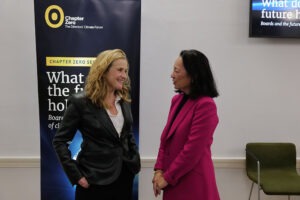
AI: great hope for business and governance challenge for boards

Emily Chien
Executive Fellow, Harvard Business SchoolClips of this discussion are available at the Chapter Zero YouTube channel here.
When corporate historians look back at this decade, they may see 2025 as the moment two transformative forces – AI and sustainability – converge. For boards, this convergence is not abstract. It defines the strategic, fiduciary and ethical frontier of modern governance. This is the topic Chapter Zero asked its audience to grapple with (an audience weighted towards committee Chairs – 24 in total – across sustainability & ESG, nomination, governance, compensation, audit, risk and remuneration committees).
AI is no longer a technical sidebar. It is reshaping the fundamentals of productivity, innovation, competitiveness and risk. At the same time, the sustainability agenda – net zero, resilience – remains existential. The question for non-executive directors is not whether to engage, but how to govern both in tandem: responsibly, and with purpose.
It is a question that is clearly high on the agendas of board members participating in the event. From a show of hands, only a small number of the 50 attendees did not see AI and its relationship to sustainability as a key topic in board discussions. But it is clear from the peer exchange that boards are struggling with the governance implications of AI adoption, albeit that different boards are focusing on different aspects of the challenge.
From data privacy to deployment decisions, to transparency issues and questions around guardrails and the fragmentation of approach, the questions in the room focused, unsurprisingly, on risk. Feedback tells us that many key points and clarifications are making their way back from the event to Chapter Zero members’ boardrooms.
Theme 1: AI’s dual edge – power and paradox
AI has been evolving since the 1950s, but today’s generation – from generative to agentic systems – represents a leap. New AI models can plan, reason and act across multimodal data: text, image, video and sensor feeds. They are probabilistic, not deterministic; they generate, not just calculate.
The paradox is stark. On one hand, AI is already delivering measurable efficiency gains – Microsoft reports up to 30% of code generation assisted by Gen AI, and JPMorgan has saved $2bn through operational business automation. On the other, the environmental and social footprint is rising sharply: a ChatGPT prompt can consume 10 times more energy than a traditional Google search, and creating a five-second SORA video is about 300 times more energy-intensive. The AI ecosystem, chip production, model training, data centre construction and operations as well as training and inference demands rare minerals, water for cooling and energy for AI compute – raising sustainability and human-rights questions.
The message for boards: AI is not a silver bullet, but it can be one of our most powerful tools – if governed wisely.
Feedback from the room centred on the bigger picture. How should boards visualise where the technology is headed; and what does that mean for governance? It was obvious from the discussion that some boards are struggling with access to information and the reassurance they need that they have the skills, data and guardrails in place to sign off an AI-oriented strategic plan and the associated huge investment.
Theme 2: AI as an accelerator for the net zero transition
One of the most exciting frontiers is AI for sustainability. Of many, we discussed three examples:
- Climate risk and resilience – AI powers global early-warning systems, geospatial forecasting and disaster resiliency. The World Meteorological Organization has called for global collaboration to harness AI’s 'life saving potential'. Google’s ‘geospatial reasoning’ models integrate real time satellite data to pinpoint communities most at risk, in minutes rather than days.
- Sustainability reporting and audit – as the complexity of climate and sustainability reporting mounts, AI can help harmonise complex, disparate data, assist with materiality assessments or report drafts, and vendor compliance monitoring across supply chains.
- Energy grid optimisation – from proactive grid predictive maintenance, grid stability and balancing, renewables integration, demand forecasting and shifting, faster infrastructure planning, AI saves money, improves grid resiliency, efficiency and reduces energy waste.
In short, AI is not only making sustainability measurable – it’s making it manageable.
Participants in the room pointed to the uneven playing field for AI adoption around the world. While some jurisdictions are, for example, linking their energy security and even their defence policy to the uptake of AI tools, others are less advanced on the policy front. This all trickles down to corporate strategy and governance.
Theme 3: sustainable AI – managing the footprint of intelligence
As AI drives the sustainability agenda, it also creates its own sustainability challenge. The International Energy Agency projects that data-centre electricity use will double by 2030, to 945 terawatt-hours.
The response from industry is promising; new chips like NVIDIA’s Blackwell deliver 25 times more energy efficiency and 30 times faster performance; smaller, pruned models reduce compute demand; smart data centres shift AI workloads to match renewable generation; hyper-scalers are co-locating data centres at renewable energy or nuclear energy sites.
For boards, the imperative is to incorporate both sustainability benefits and the embedded CO2 impact of growing AI deployments and use LCA to understand ‘cradle to grave’ environmental impacts.
These are new considerations for boards. Where you deploy AI matters was a key message from the floor, with participants pointing out that AI deployment is never generic; it is specific and needs guardrails. Whether to deploy is made even more complex by the dearth of data related to AI providers’ carbon footprints – how to calculate carbon emissions resulting from AI adoption was a palpable concern.
Theme 4: governance for the age of AI systems
Boardrooms are in the early stages of incorporating both sustainability and AI in corporate governance. According to NACD data, 62% of boards now allocate time to AI, up from 28% in 2023 – yet only one in three has an AI governance framework, and only 27% include AI oversight in committee charters.
These numbers were reflected in the response from the room – they are even a little conservative. While participants were clearly on board with AI as an enabler for transition, risk was the key concern.
AI governance and sustainability governance share common DNA: both rely on data integrity, cross-functional oversight and an ethical compass. They share an opportunity for value creation alongside heightened risks across functions and jurisdictional complexity. But boards often treat them as silos. The next evolution is integrated governance – embedding AI and sustainability oversight not only within enterprise risk management, compliance and audit but to leverage both in core business strategy and operational execution. Boards must ensure:
- Clarity of accountability – which committee(s) owns AI oversight?
- Capability and literacy – do directors understand the technology well enough to challenge management?
- Culture and incentives – are sustainability and responsible AI embedded in metrics, compensation and purpose?
The new ‘boardroom unicorn’ will be the director who can bridge tech/AI, governance, and sustainability – translating risk into opportunity and complexity into value creation.
Looking ahead: shaping the future
Directors who thrive in this new era will see AI not as a black box, but as a critical tool to help inform the choices we make about growth, equity and the planet we share.
The challenge – and the opportunity – for NEDs, who are bound by fiduciary duty, is to ensure that innovations serve humanity, sustainability and long-term enterprise value.
That is the leadership Chapter Zero was founded to inspire.









